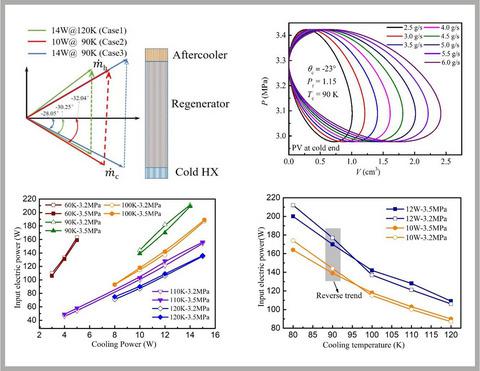当前位置:
X-MOL 学术
›
Energy Sci. Eng.
›
论文详情
Our official English website, www.x-mol.net, welcomes your feedback! (Note: you will need to create a separate account there.)
Effects of cold‐end temperature and heat load on the cooling characteristics of a pulse tube refrigerator
Energy Science & Engineering ( IF 3.8 ) Pub Date : 2019-11-14 , DOI: 10.1002/ese3.545 Shaoshuai Liu 1 , Zhenhua Jiang 1, 2 , Lei Ding 1 , Haifeng Zhu 1 , Xiaoping Qu 1 , Yinong Wu 1, 2
Energy Science & Engineering ( IF 3.8 ) Pub Date : 2019-11-14 , DOI: 10.1002/ese3.545 Shaoshuai Liu 1 , Zhenhua Jiang 1, 2 , Lei Ding 1 , Haifeng Zhu 1 , Xiaoping Qu 1 , Yinong Wu 1, 2
Affiliation

|
A pulse tube refrigerator (PTR) was developed to operate at different cooling capacities to meet the requirements of various applications. Changes in the thermal loads or the long operating time of the PTR will influence the cold conditions (cold‐end temperature and heat load), leading to a deviation of the cooling performance from the optimal design conditions. The basic principles of the mass flow characteristics of the PTR are constructed based on enthalpy phase modulation, which is helpful for comprehending the relationships between cold‐end parameters and other parameters. A REGEN model is introduced in which different mass flows at the cold‐end are considered to simulate the effects of the cold‐end parameters on the performance of the regenerator. The influences of the cold‐end temperature and heat load on the cooling performance are investigated by using a coupling model of a DeltaEC model and a REGEN model. In addition, some experiments are performed on a PTR working at different cold‐end temperatures and heat load. The experimental results are in good agreement with the simulation results. The cooling performance of the PTR is influenced by the average pressure and operating frequency of different cooling states. Relative Carnot efficiencies of 12.2% for 4 W@60 K with a specific power of 33 W/W and 16.1% for 15 W @120 K with a specific power of 9 W/W can be achieved by the PTR using different operating parameters.
中文翻译:

冷端温度和热负荷对脉冲管制冷机冷却特性的影响
开发了脉冲管制冷机(PTR),以不同的制冷量运行,以满足各种应用的需求。PTR的热负荷或较长的工作时间变化会影响寒冷条件(冷端温度和热负荷),从而导致冷却性能偏离最佳设计条件。PTR质量流量特性的基本原理是基于焓相位调制构造的,这有助于理解冷端参数与其他参数之间的关系。引入了REGEN模型,其中考虑了冷端的不同质量流量,以模拟冷端参数对再生器性能的影响。利用DeltaEC模型和REGEN模型的耦合模型研究了冷端温度和热负荷对冷却性能的影响。此外,还对在不同冷端温度和热负荷下工作的PTR进行了一些实验。实验结果与仿真结果吻合良好。PTR的冷却性能受不同冷却状态的平均压力和工作频率的影响。通过使用不同的工作参数的PTR可以在4 W @ 60 K下以33 W / W的比功率实现12.2%的相对卡诺效率,在15 W @ 120 K下以9 W / W的比功率实现16.1%的相对卡诺效率。在不同的冷端温度和热负荷下,在PTR上进行了一些实验。实验结果与仿真结果吻合良好。PTR的冷却性能受不同冷却状态的平均压力和工作频率的影响。通过使用不同的工作参数的PTR可以在4 W @ 60 K下以33 W / W的比功率实现12.2%的相对卡诺效率,在15 W @ 120 K下以9 W / W的比功率实现16.1%的相对卡诺效率。在不同的冷端温度和热负荷下,在PTR上进行了一些实验。实验结果与仿真结果吻合良好。PTR的冷却性能受不同冷却状态的平均压力和工作频率的影响。通过使用不同的工作参数的PTR可以在4 W @ 60 K下以33 W / W的比功率实现12.2%的相对卡诺效率,在15 W @ 120 K下以9 W / W的比功率实现16.1%的相对卡诺效率。
更新日期:2019-11-14
中文翻译:

冷端温度和热负荷对脉冲管制冷机冷却特性的影响
开发了脉冲管制冷机(PTR),以不同的制冷量运行,以满足各种应用的需求。PTR的热负荷或较长的工作时间变化会影响寒冷条件(冷端温度和热负荷),从而导致冷却性能偏离最佳设计条件。PTR质量流量特性的基本原理是基于焓相位调制构造的,这有助于理解冷端参数与其他参数之间的关系。引入了REGEN模型,其中考虑了冷端的不同质量流量,以模拟冷端参数对再生器性能的影响。利用DeltaEC模型和REGEN模型的耦合模型研究了冷端温度和热负荷对冷却性能的影响。此外,还对在不同冷端温度和热负荷下工作的PTR进行了一些实验。实验结果与仿真结果吻合良好。PTR的冷却性能受不同冷却状态的平均压力和工作频率的影响。通过使用不同的工作参数的PTR可以在4 W @ 60 K下以33 W / W的比功率实现12.2%的相对卡诺效率,在15 W @ 120 K下以9 W / W的比功率实现16.1%的相对卡诺效率。在不同的冷端温度和热负荷下,在PTR上进行了一些实验。实验结果与仿真结果吻合良好。PTR的冷却性能受不同冷却状态的平均压力和工作频率的影响。通过使用不同的工作参数的PTR可以在4 W @ 60 K下以33 W / W的比功率实现12.2%的相对卡诺效率,在15 W @ 120 K下以9 W / W的比功率实现16.1%的相对卡诺效率。在不同的冷端温度和热负荷下,在PTR上进行了一些实验。实验结果与仿真结果吻合良好。PTR的冷却性能受不同冷却状态的平均压力和工作频率的影响。通过使用不同的工作参数的PTR可以在4 W @ 60 K下以33 W / W的比功率实现12.2%的相对卡诺效率,在15 W @ 120 K下以9 W / W的比功率实现16.1%的相对卡诺效率。



























 京公网安备 11010802027423号
京公网安备 11010802027423号